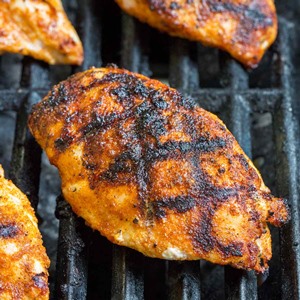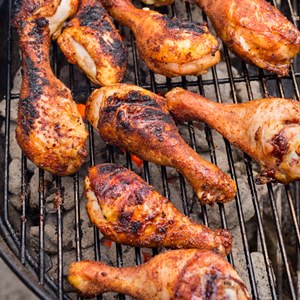No matter how big of a fan of poultry you are, eating a delicious grilled chicken leg or wing is always a tasty experience. Cultures from all around the world have some sort of preparing chicken using a burning pit of coal, and we are going to address every aspect of grilling chicken meat, and chicken as a whole.
Chicken needs to be prepared with care if you want to hit that golden spot of juicy meat. Out of all meats that you can grill, chicken meat needs a bit of special attention, not only for the flavor but for health reasons as well.
We are inviting you to stick around and see how to improve your grilling skill, regardless of the grill skill you possess, both professionals and amateur pit masters are welcome. After all, knowledge is the first step towards deliciously grilled meat.
Before You Start!
 Putting the chicken in the grill is easy. Before we get to that part, there are essential things we need to cover, including the gear you will use, and the core information about chicken meat. This type of meat tends to burn easily, and if it’s undercooked it can be a health hazard. Do not be afraid, though. After we are done with this guide, you will be armed with the necessary knowledge to prepare your own finger-licking grilled chicken.
Putting the chicken in the grill is easy. Before we get to that part, there are essential things we need to cover, including the gear you will use, and the core information about chicken meat. This type of meat tends to burn easily, and if it’s undercooked it can be a health hazard. Do not be afraid, though. After we are done with this guide, you will be armed with the necessary knowledge to prepare your own finger-licking grilled chicken.
Hardware and tools
The key ingredient to any tasty recipe is a reliable grill. There are several types of commonly-used grills out there, with gas, charcoal, and electric being the main three. Every type has its ups and downs, but when we say reliable grill, we only want one thing to work perfectly, and that is the temperature control!
Electric and small gas grills have an easy system of temperature control, usually in the form of dials or gauges. The more you are comfortable with using them, the better. Charcoal, on the other hand, has a slightly less reliable temperature control system, so getting one of those top-rated bbq temperature controllers would be ideal.
However, we would like to stress out one piece of hardware that every grill master should have at his/her disposal: an instant read meat thermometer. They are reliable, and you will need one to measure the inner temperature of the meat, as well as the surrounding temperature. Every experienced grill master knows that getting that perfect color and meat texture is not about cooking time, but it is all about temperature (internal and external).
Know your grill!
This one goes out to every grill owner, but we want to emphasize the importance of knowing the grill for charcoal type owners. Tabletop charcoal grills have a different heat regulation system, and the ideal scenario would be if you knew it by heart. Knowing how to control the air vents (usually located on the top and the bottom of the grill) is key to a solid heat controlling routine. Do not be afraid to experiment, because the more you do the tastier the results will be.
Additionally, we will leave this table of commonly-used terms for grill temperatures, and what are their actual values in degrees Fahrenheit:
- Low heat – 250-275°F
- Medium-low heat – 300°F
- Medium heat – 350°F
- Medium High 400-450°F
- High – 500-650°F
- Cremation – 650+°F
The Basics of Chicken Grilling Temperatures
 Measuring both internal and external meat temperature is important, but to avoid any health risks, and to ensure that the meat is at its most delicious point, you will have to take care of internal temperature with all seriousness.
Measuring both internal and external meat temperature is important, but to avoid any health risks, and to ensure that the meat is at its most delicious point, you will have to take care of internal temperature with all seriousness.
According to the FDA, the minimum internal temperature for cooking chicken, regardless of the method used, is 165 degrees Fahrenheit. This might not sound as much, but to achieve this internal temperature, it means that the overall heat must be higher during the whole process.
There are not many indicators about the doneness of chicken, besides temperature, that you can completely trust. One of the more common “methods” of checking the meat is cutting it and observing the juices that run from inside. Some say that if the juices are clear, there is no need to worry and the meat is done. However, regardless of this making sense, you can’t trust this parameter because different meat has different properties. For example, an older chicken will make those juices run clear more easily, even though it might not be ready.
When it comes to health, the safest bet would be to see a thermometer and be 100% sure that the chicken meat achieved the temperature above 165 degrees Fahrenheit.
Overcooking and undercooking the meat, what are the effects?
No one was born with a grill experience, and you should prepare yourself for the fact that not every piece of chicken will turn out perfect.
- Overcooking chicken – This usually happens when people try to get slightly crispier chicken skin, and they disregard the inner side. An overcooked chicken will often have a savory, or even bitter, flavor, due to all the water and fat evaporating and burning while inside the chicken. This is not considered a health hazard, however, it is not as healthy, nor as tasty, as you might think. Besides, an overcooked chicken will be dry and hard to chew, and there’s barely anything you can do to reverse this process.
- Undercooked chicken – Now, this is a situation to be avoided, for reasons that are commonly known. The biggest reason to avoid eating undercooked chicken are bacteria and other microorganisms, with salmonella being the most notorious one. Besides the dangerous health hazard, undercooked chicken is flavorless and it will not go down easily. But, in contrast to overcooking it, undercooked chicken can be returned to the fire to be heated for a longer period of time.
The effects of bones, skin and meat girth on grilling time
If you’ve ever dealt with grilling any type of poultry meat, you have surely noticed a rule when grilling with bone in. Chicken bone is harder to heat up, and it actually contributes to faster cooling of the piece, so it is always advised to prolong grilling time when dealing with meat that has a bone in it. This rule may not apply for bone-in chicken breast in its entirety, because the bone is only in the middle, smaller part.
Another factor that can greatly affect chicken grilling time is the skin. As you probably already know, chicken skin is full of fats, and these fats act as an insulator. Even more than the bones, chicken skin can prolong, or sometimes even double the total time of grilling. However, mastering how to cook chicken with the skin on reaps the reward of crispy chicken skin taste over a juicy leg or drumstick. The devil is in the details.
Lastly, the effect of chicken meat thickness and age must be taken into account. The older and the thicker the meat, the longer it will have to spend on the grill. If you want to shorten the grilling time, all you have to do is cut into smaller and thinner pieces. However, that is not always possible or even wanted. If thinning the meat is not possible, as is the case of marinating chicken, you will have to spend extra time grilling it.
Grilling Times
Now that we have gone through the basics of temperature and general heating processes of grilling chicken, it is time to divide the whole bird and take a look at every part separately. Grilling a whole chicken nowadays is not that common, but if pulled out right, it can be even tastier than cooking separate parts.
- Chicken breast, boneless, skinless: 6 to 8 ounces – 8 to 12 minutes over direct medium heat
- Chicken breast, with bones: 10 to 13 ounces – 30 to 40 minutes over indirect medium heat
- Chicken leg or thigh, with bones:7 to 12 ounces – 30 to 40 minutes over indirect medium heat
- Chicken thigh, boneless, skinless: 4 to 6 ounces – 8 to 10 minutes over direct high heat
- Chicken wings: 2 to 3 ounces – 18 to 20 minutes over direct medium heat
- Whole chicken: 3 ½ to 4 ½ pounds – 1 ½ to 2 hours over indirect medium heat
We advise that you take these time markings with a slight reserve. There are more factors to grilling chicken that just time and temperature, of course.
1. How long does it take to grill chicken breast(boneless & with bones)?
This is by far the most common form of chicken meat that people like to prepare, and it as the shortest preparation time. Chicken breast is a piece of low-fat meat and should be grilled with care because overcooking it is not that hard.
An average sized piece of chicken breast (around 8 ounces) will take about 10 to 15 minutes on a direct fire, with at least 5 minutes spent on each side. This stands for a boneless and skinless piece of chicken breast.
With the bone in, you should consider doubling the times for each side, capping at 10 minutes each. Take extra care with preventing the edges from going too dark. The part of the meat that gets charred can give a flavor too strong and bitter, so keep your thermometer at hand. If you are not sure, start it on indirect heat, and swap to direct heat midway through.
2. How long does it take to grill chicken thighs and drumstick?
These parts of the chicken almost always come bone in, which means, you’ve guessed it, longer grilling time. Both should be cooked for at least 40 minutes because bones, skin and extra fat require longer heat exposure.
The most popular way of cooking drumsticks, because of the crispy skin, of course, is to combine indirect and direct heat in a 3-1 time ratio, on medium-high temperature. This way the insides get to be cooked completely, and the skin can be turned into a golden crust.
In the last 10 minutes of grilling on direct heat, you should be careful of searing too much and burning the skin. But, because of the nature of this meat, it is not that easy to overcook it.
3. How long does it take to grill chicken wings?
Another quite popular choice among grill chefs and grill lovers, in general, are the chicken wings. They almost always come with the bone in, but the size of chicken wings is the smallest compared to the rest. This means that you will have to grill it on medium temperature, for 20 to 25 minutes.
Now, the different thing with chicken wings is that you will have to flip them more often, approximately every 3 minutes. This is due to their size and due to their ability to burn easily.
Chicken wings are almost always cooked on the direct fire, so make sure you utilize the thermometer in order to not overcook or undercook them.
4. How long does it take to grill chicken leg quarters?
Next, to whole chickens, leg quarters have the most bone mass, making them the slowest to cook. They are also considered the darkest part of the meat, so it is advised to cook them until the inner temperature reaches somewhere between 180 to 195 degrees Fahrenheit.
For best results, grill the quarters over an indirect heat source for 35 to 45 minutes, and finish the quarters off on a direct heat source for 10 to 12 minutes, for that extra flavor.
5. How long does it take to grill a whole chicken?
The general rule is to grill 20 to 25 minutes per pound (total weight, not just meat mass). So, for a 5-pound chicken 100 to 125-minute grilling session will be in order, and the temperature may vary, depending on the chicken age and fat percentage.
When cooking a whole chicken, it would be ideal to have multiple thermometer probes and measure dark and light meat separately. Another great tool you could use is a rotary system of some sorts, to help spread the heat in the best way possible. Being that this process takes quite some time, make sure to refill the grill with charcoal, and maintain the proper cooking temperature.
A Final Note
Many professional experts consider chicken as the healthiest type of meat, next to some fish sorts. Grilling is a healthy food preparation process, so combining the two can be great if you are looking for a tasty and rich protein source, with little fat content.
The key to well-grilled chicken is patience, and some experimenting, which we as GrillnSkill encourage you to do.
So, let’s get grilling!
